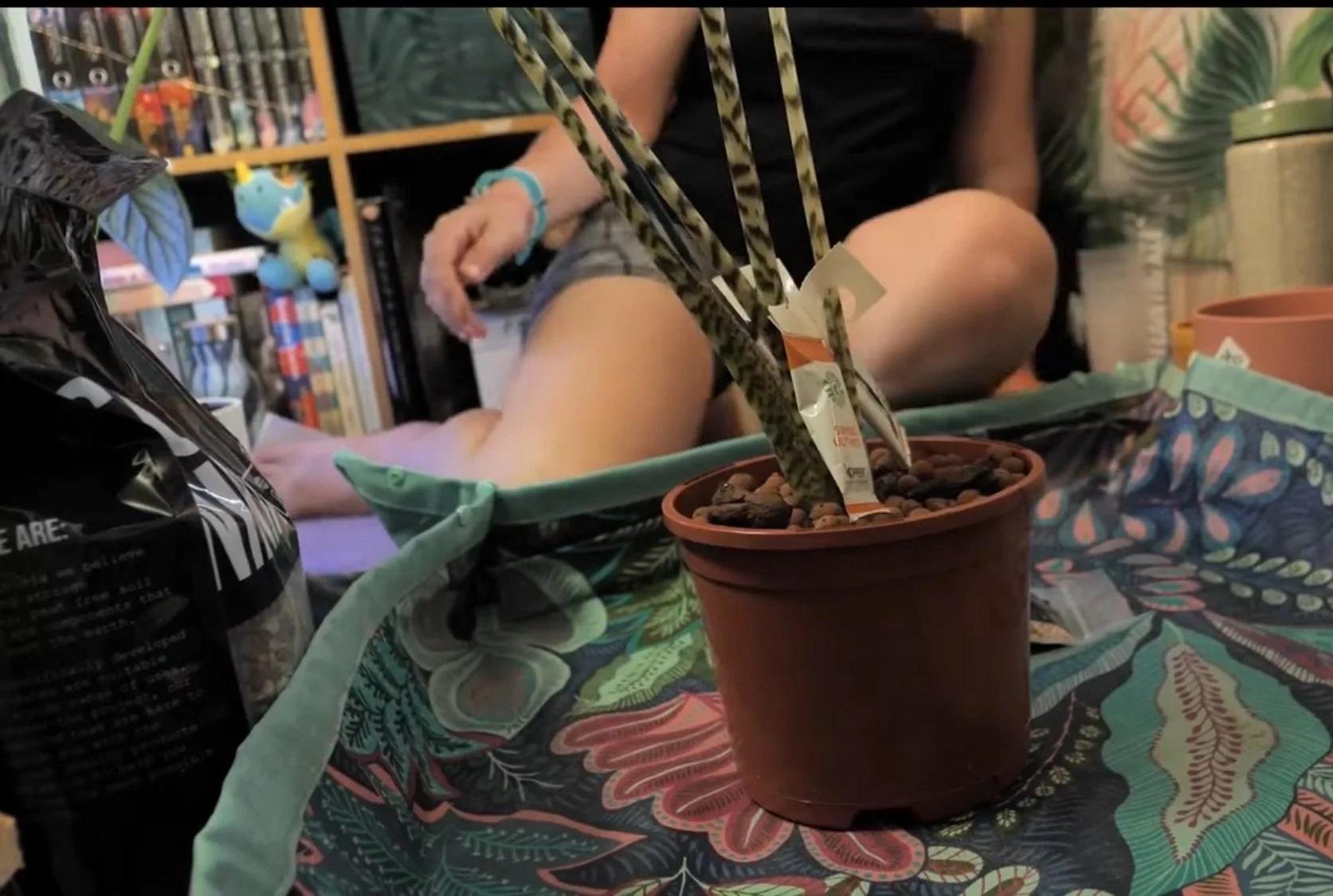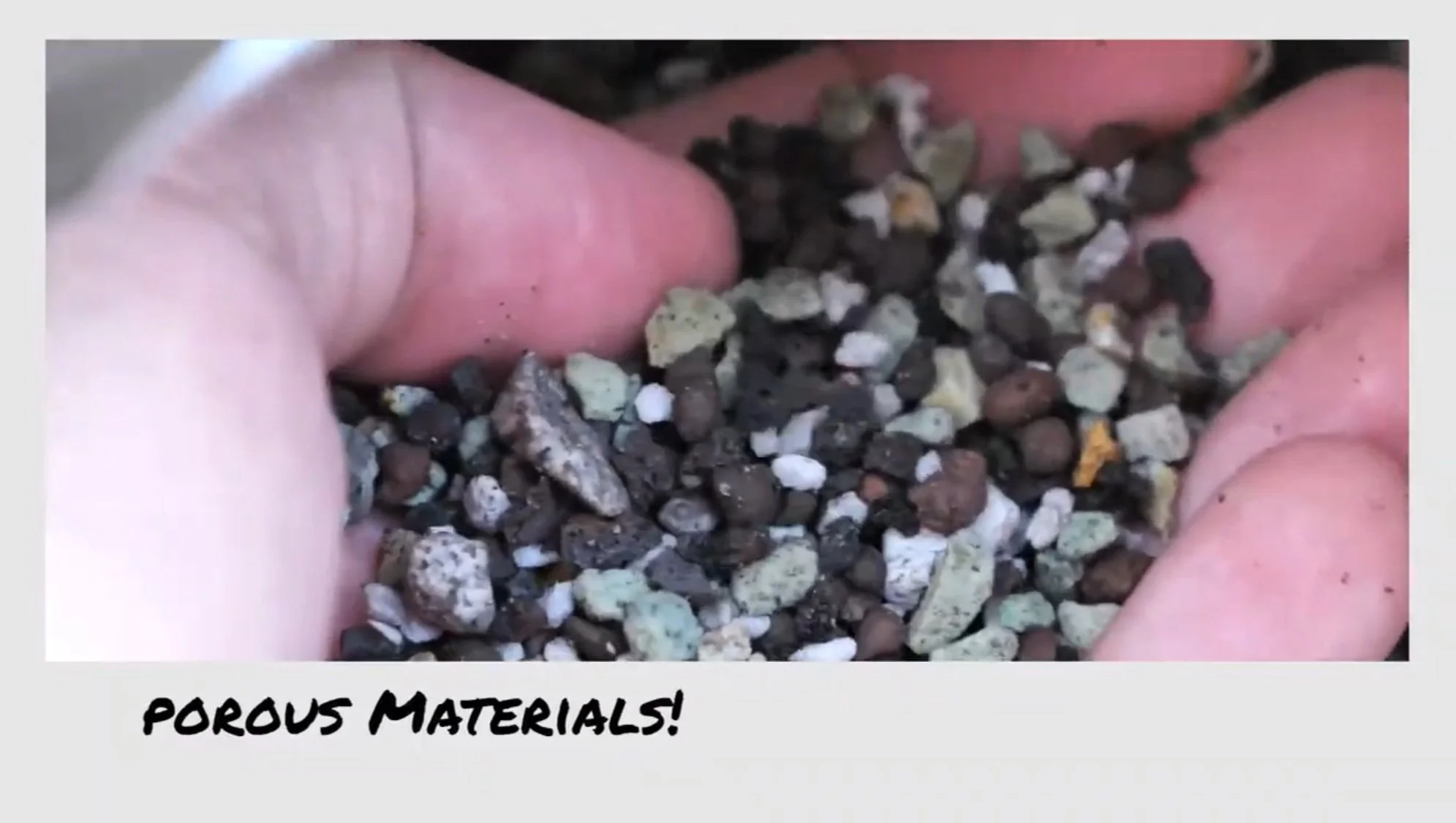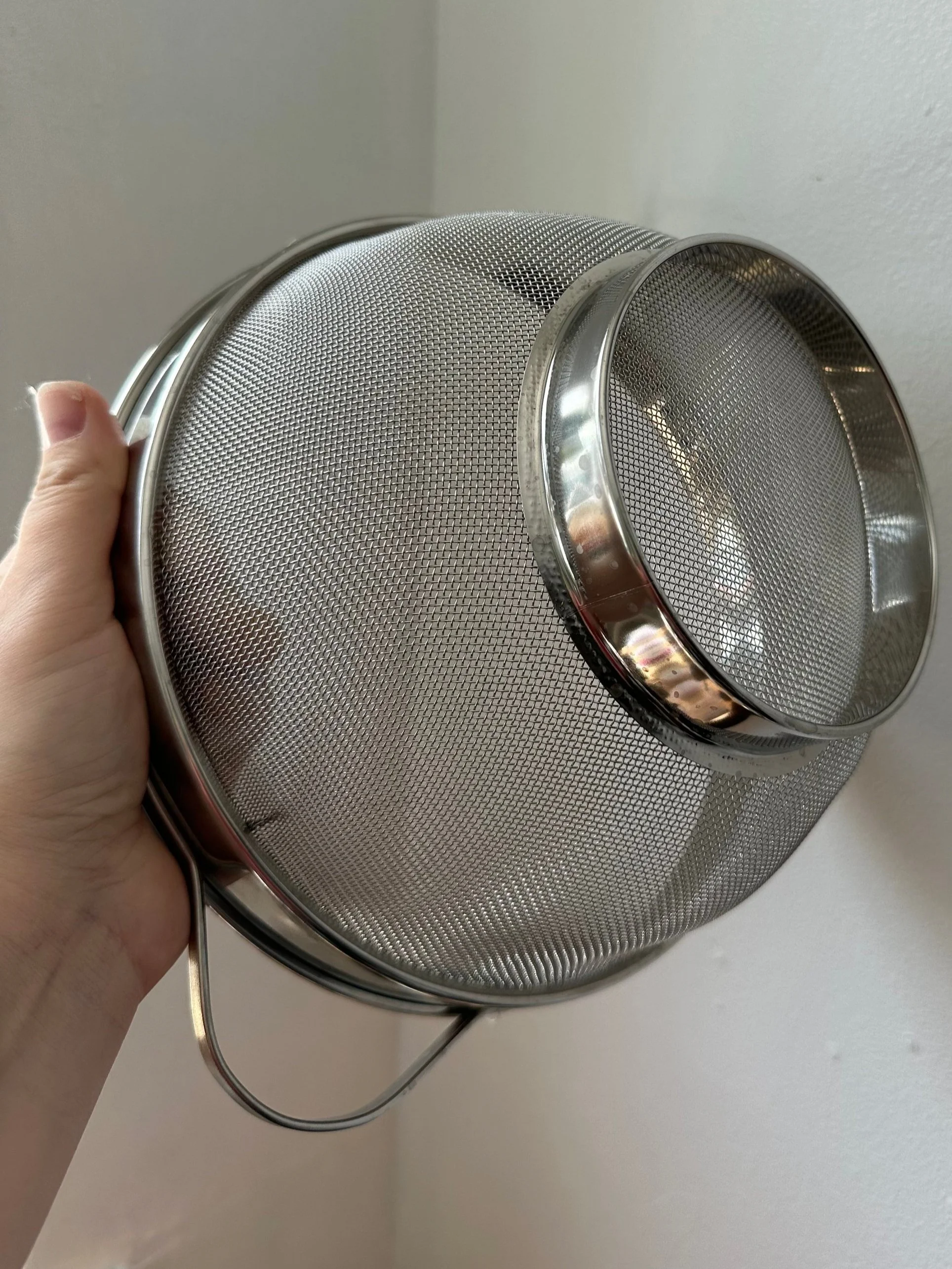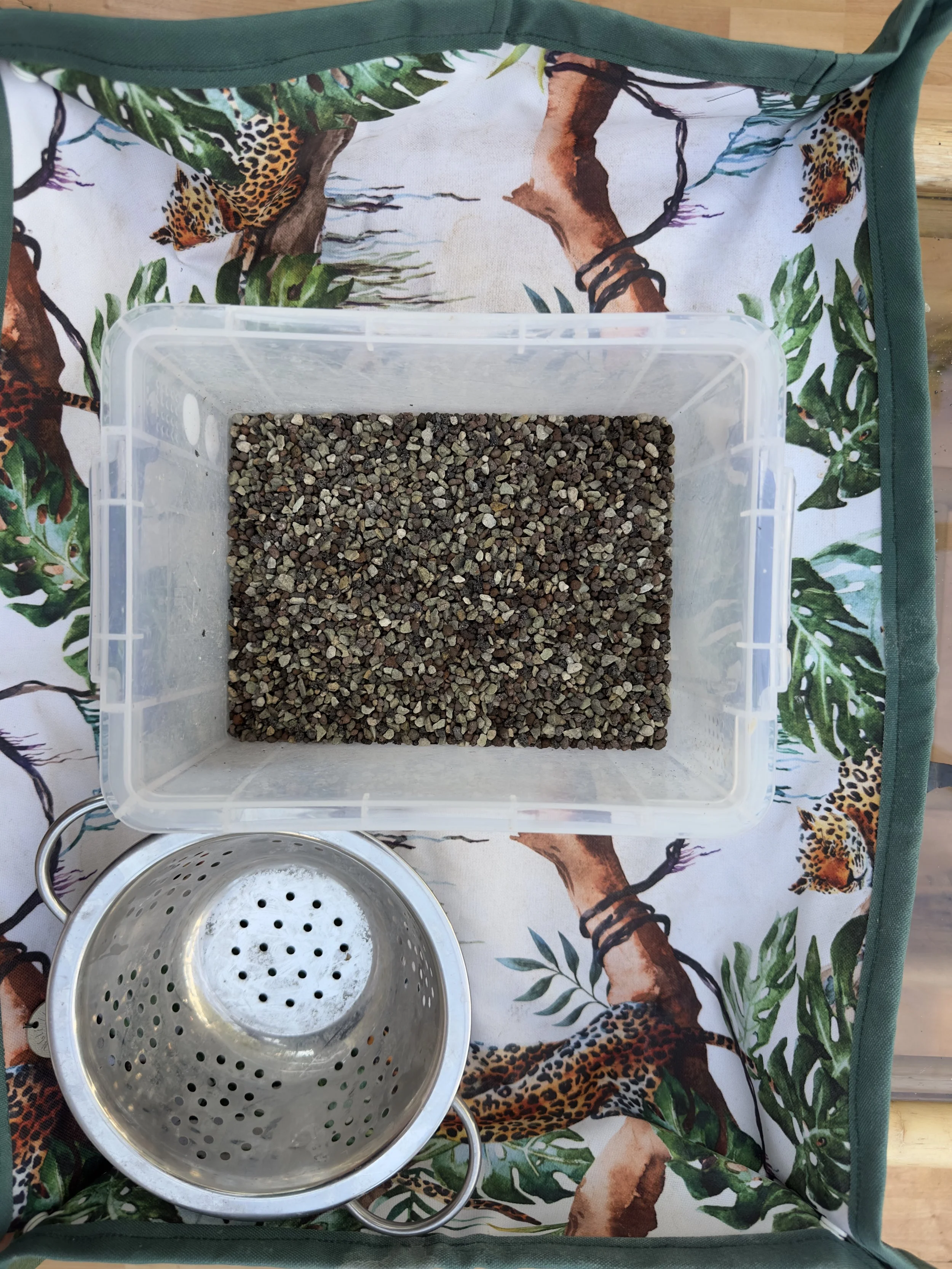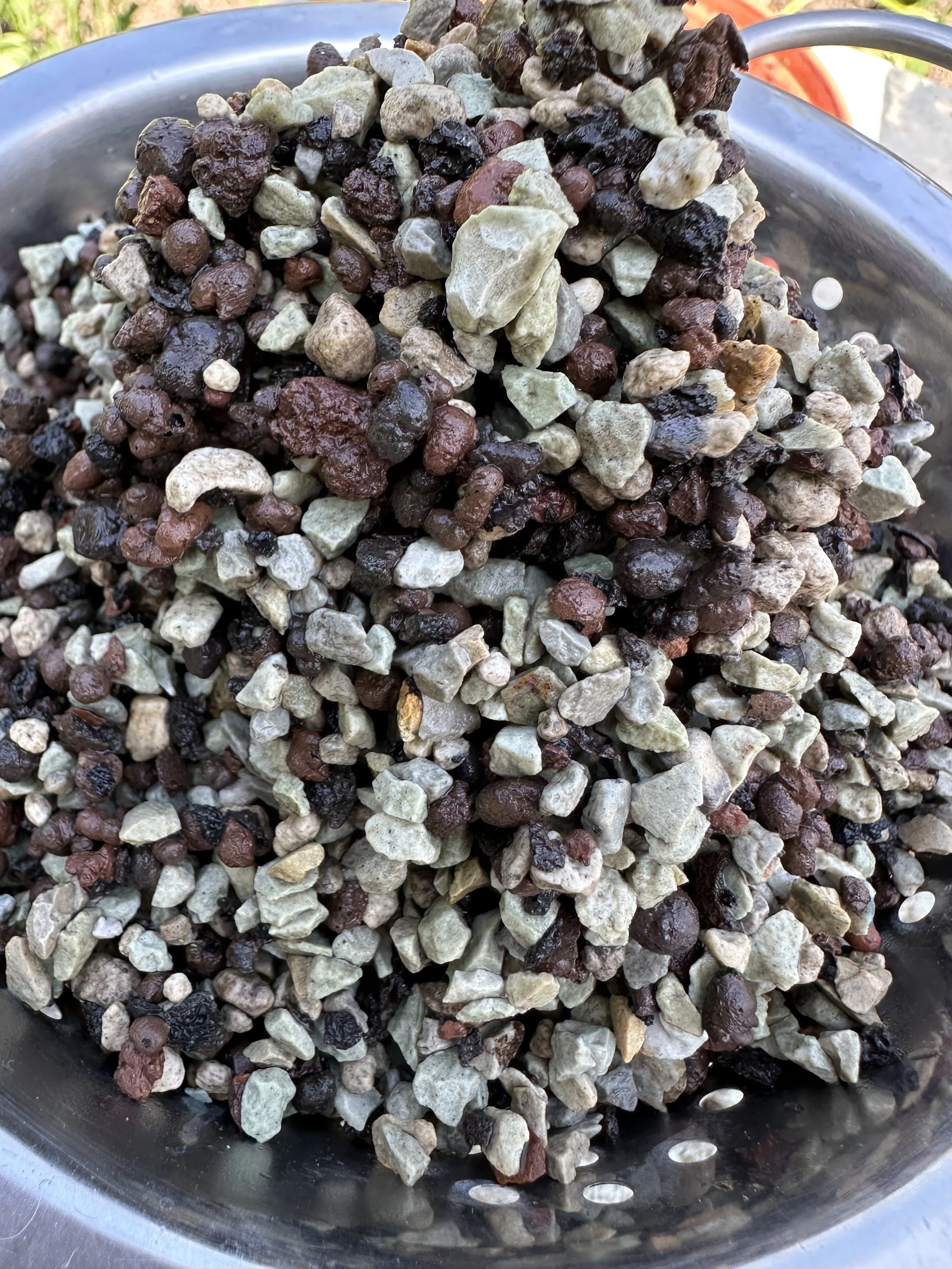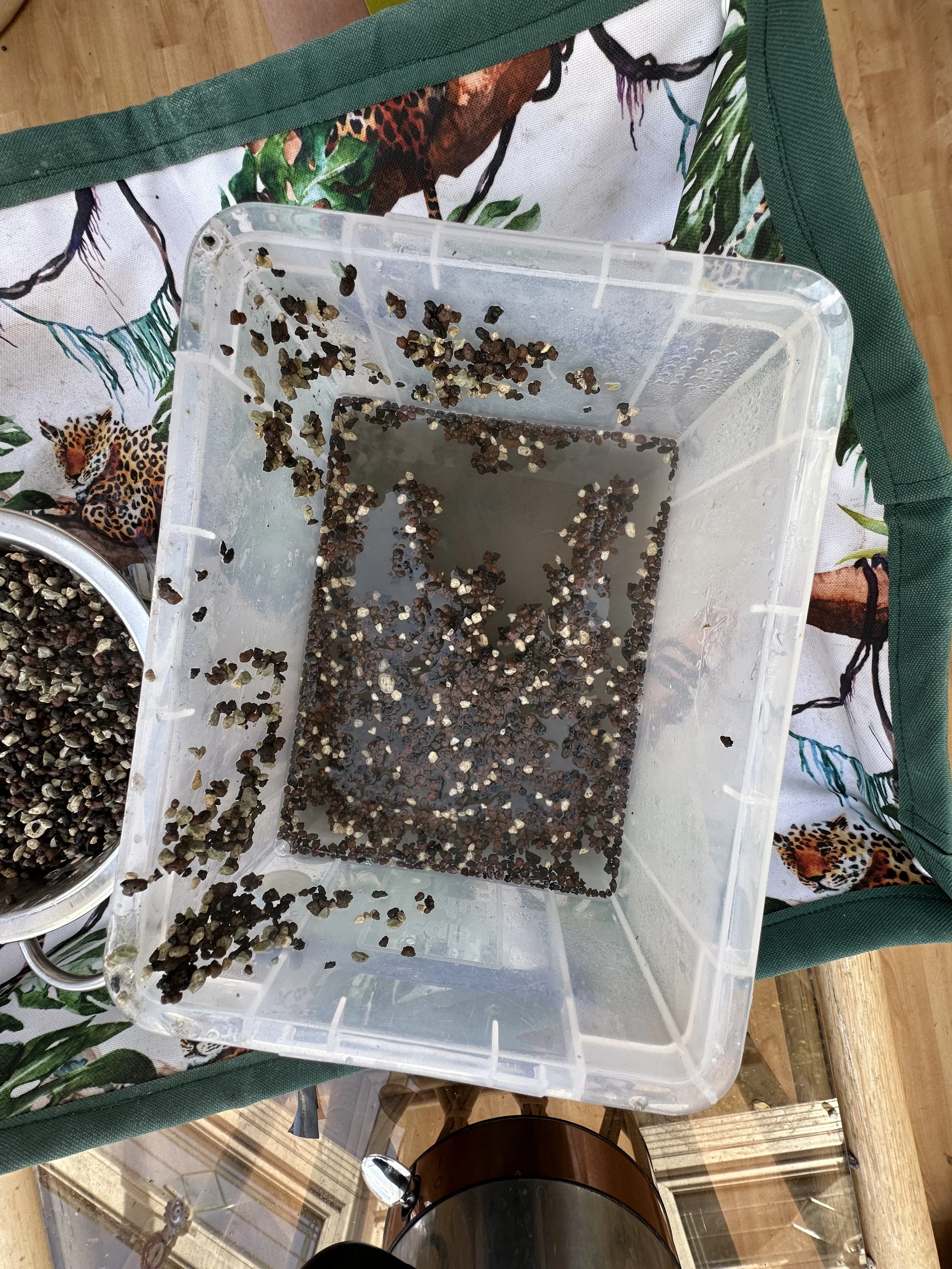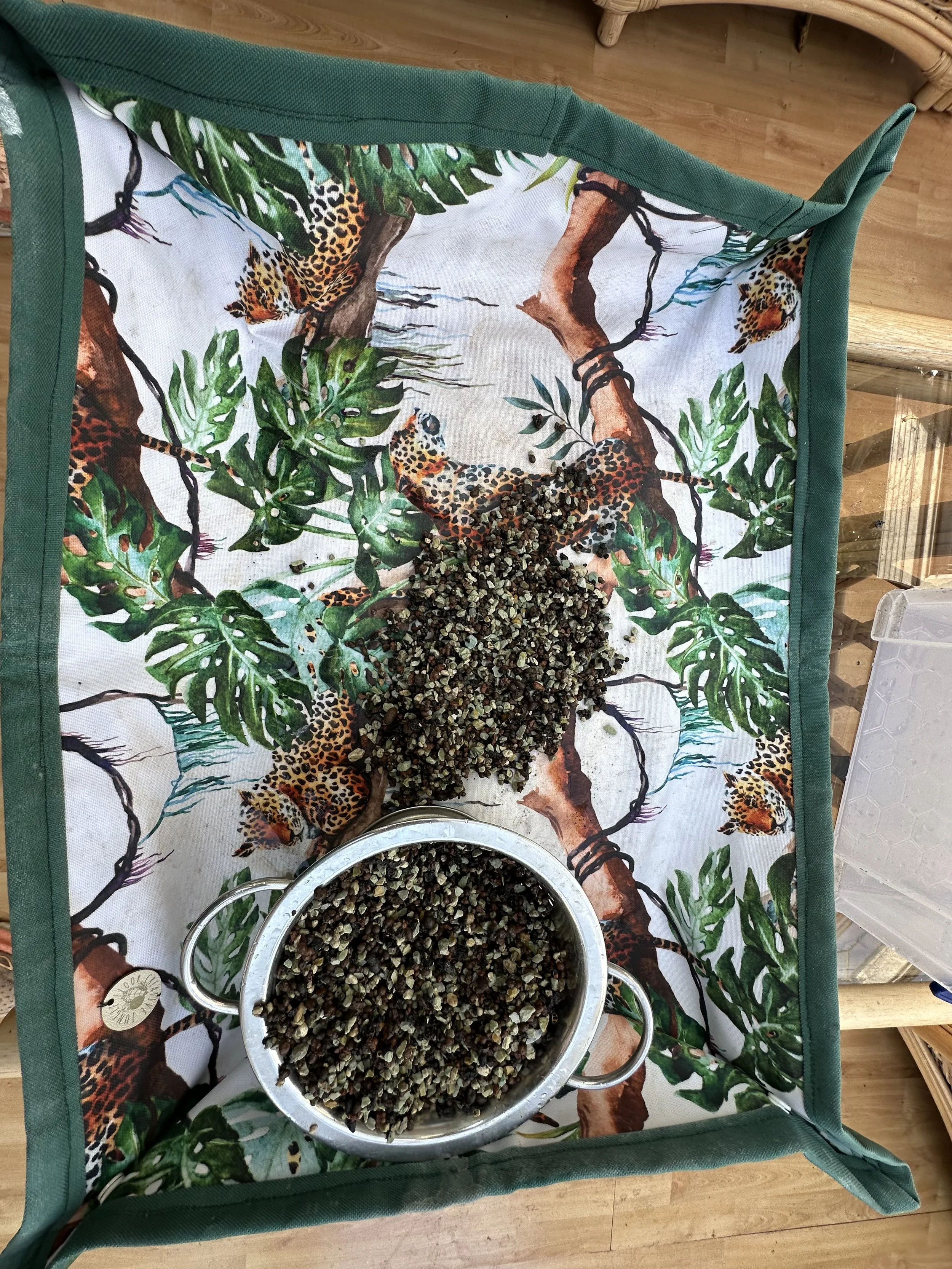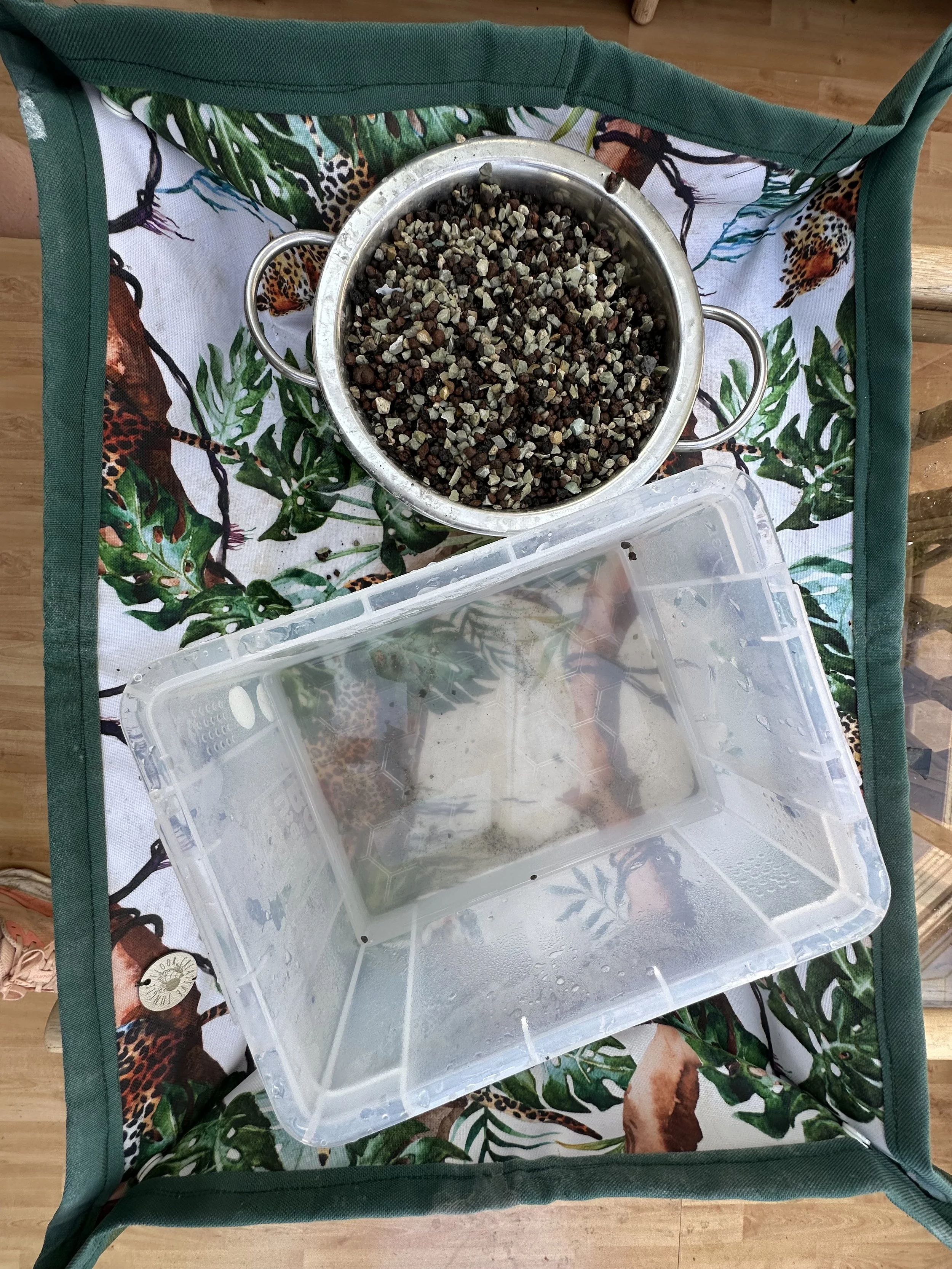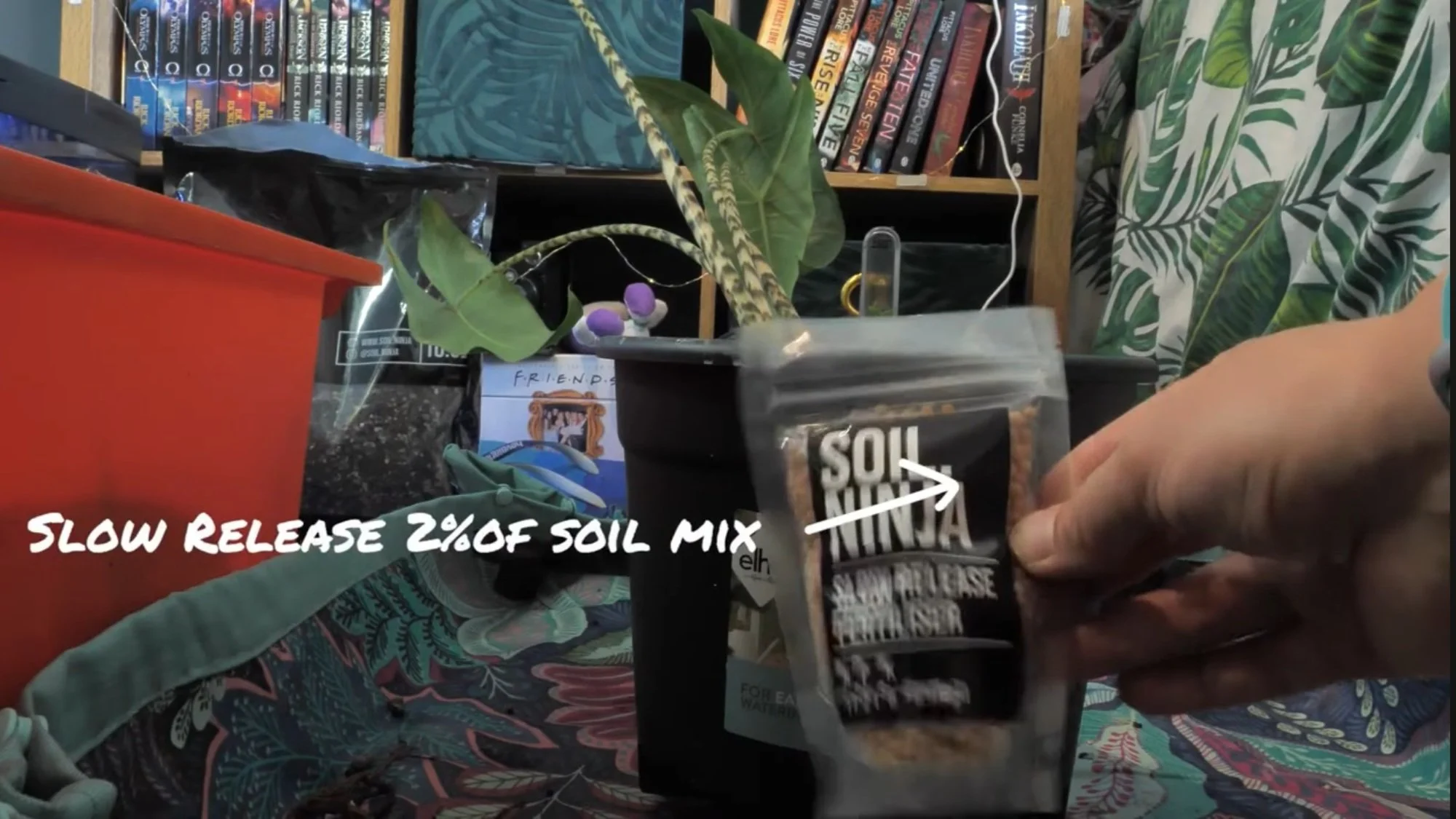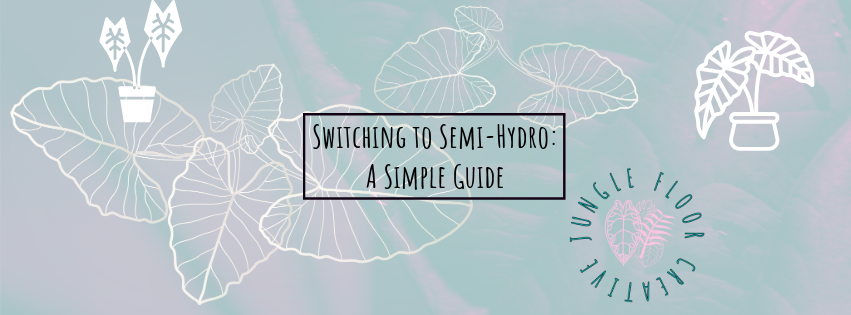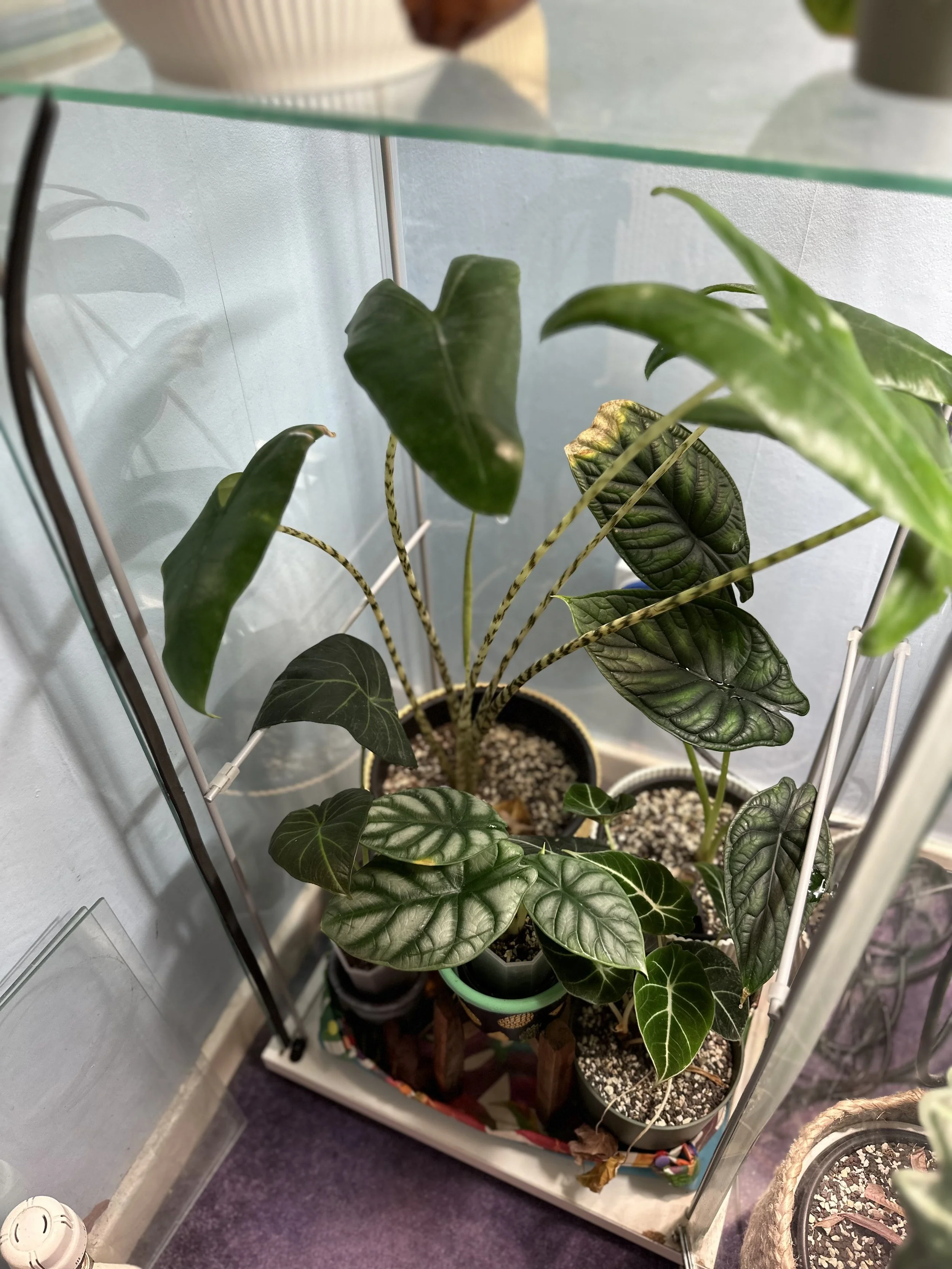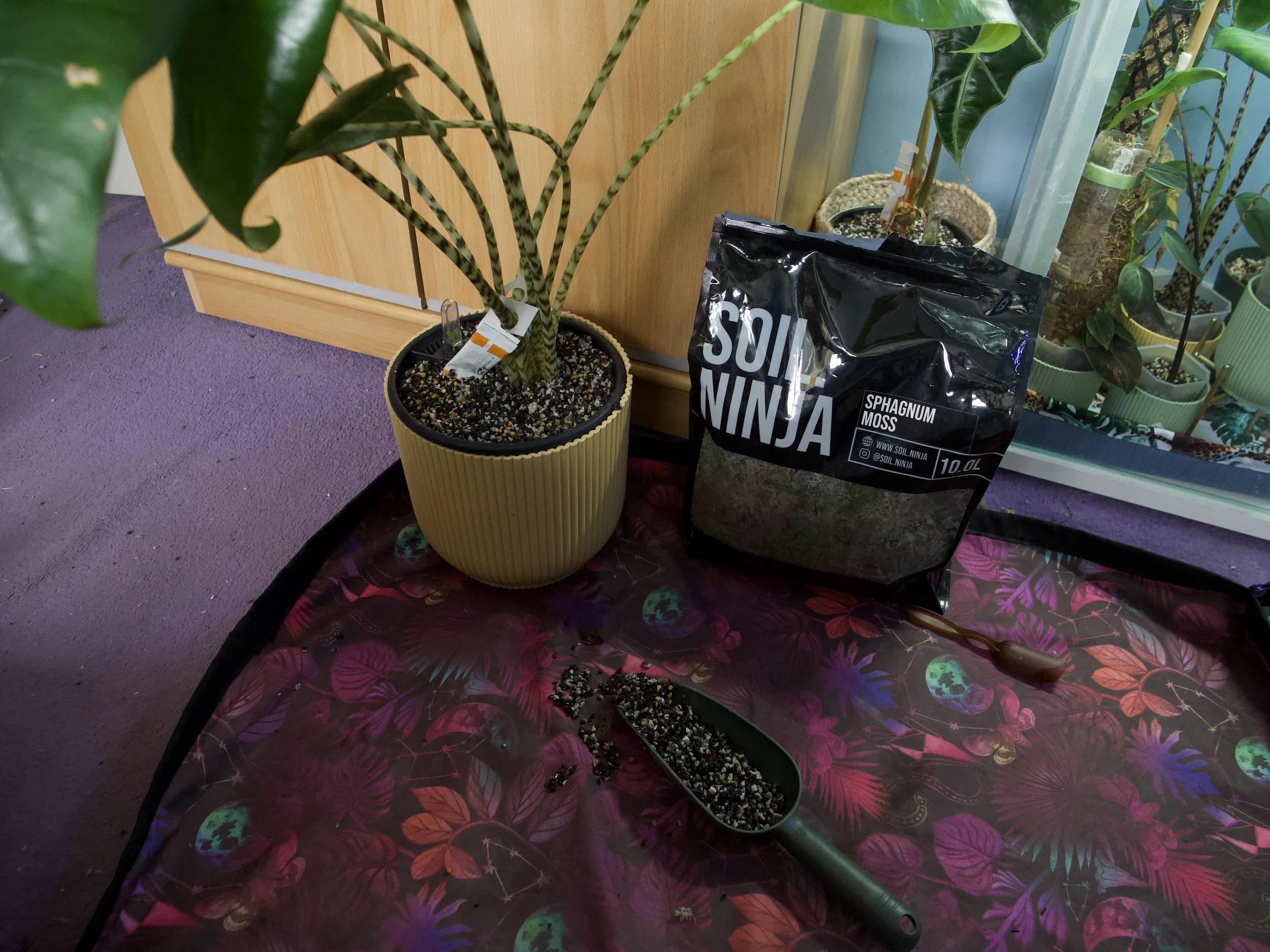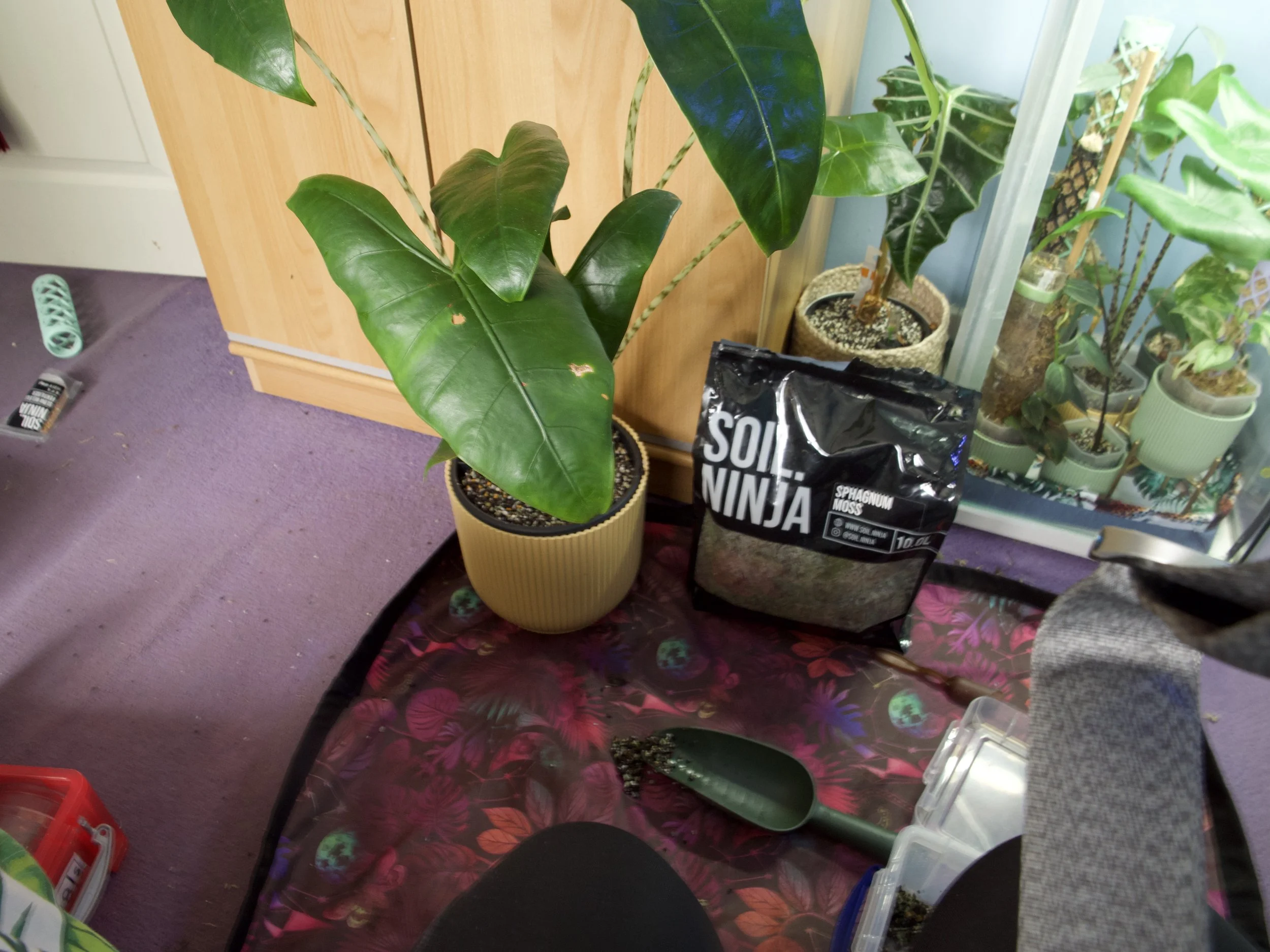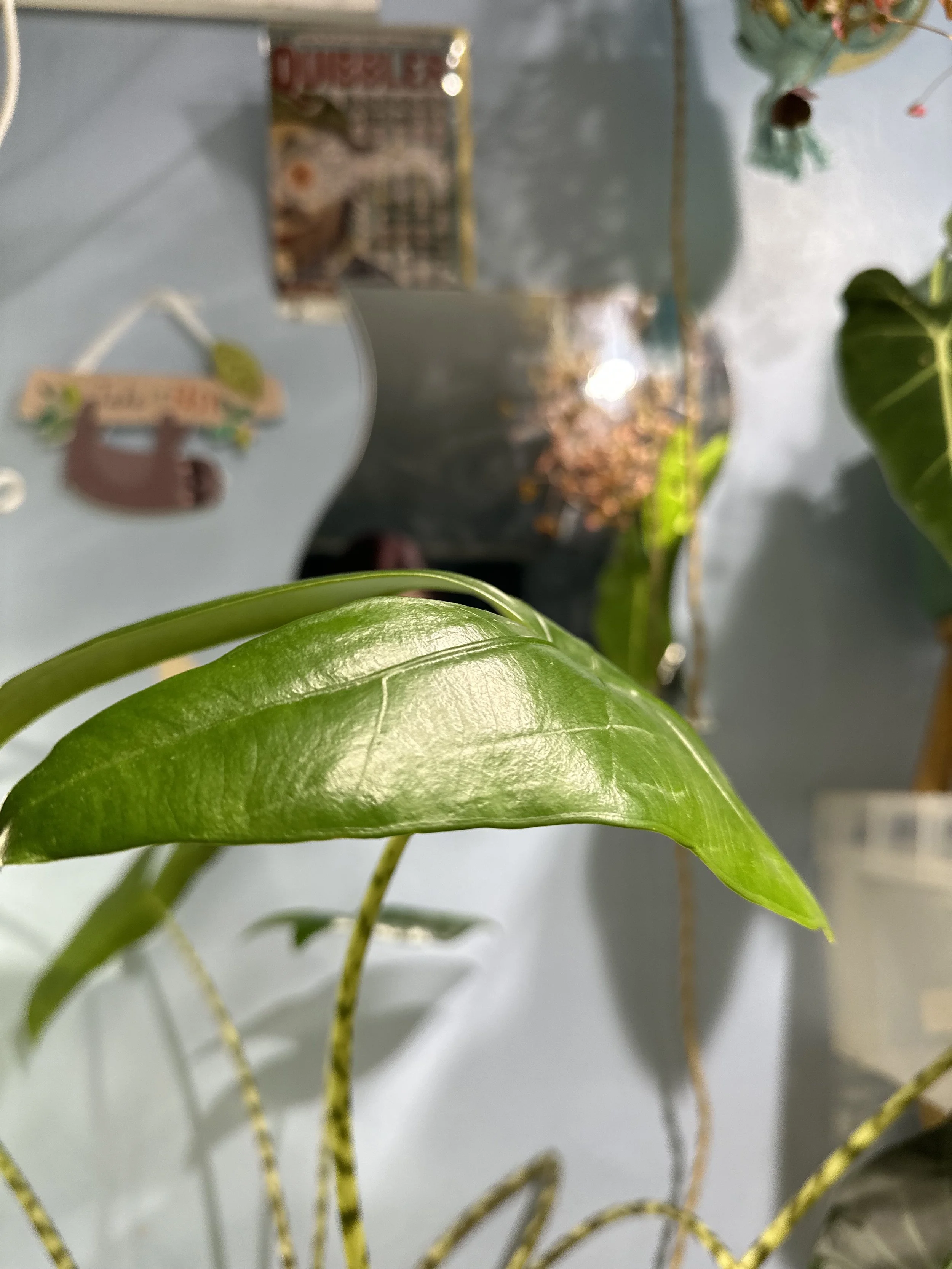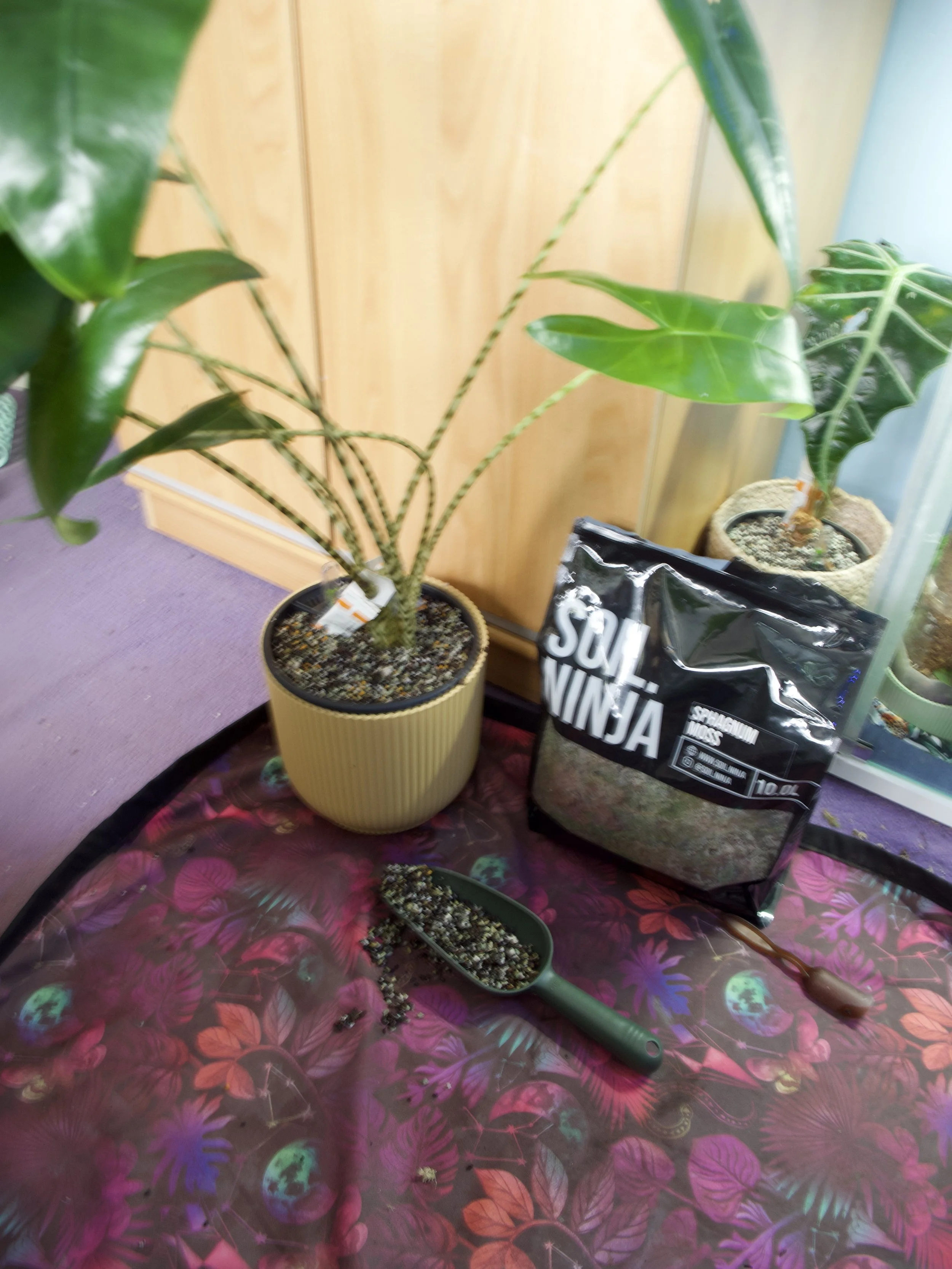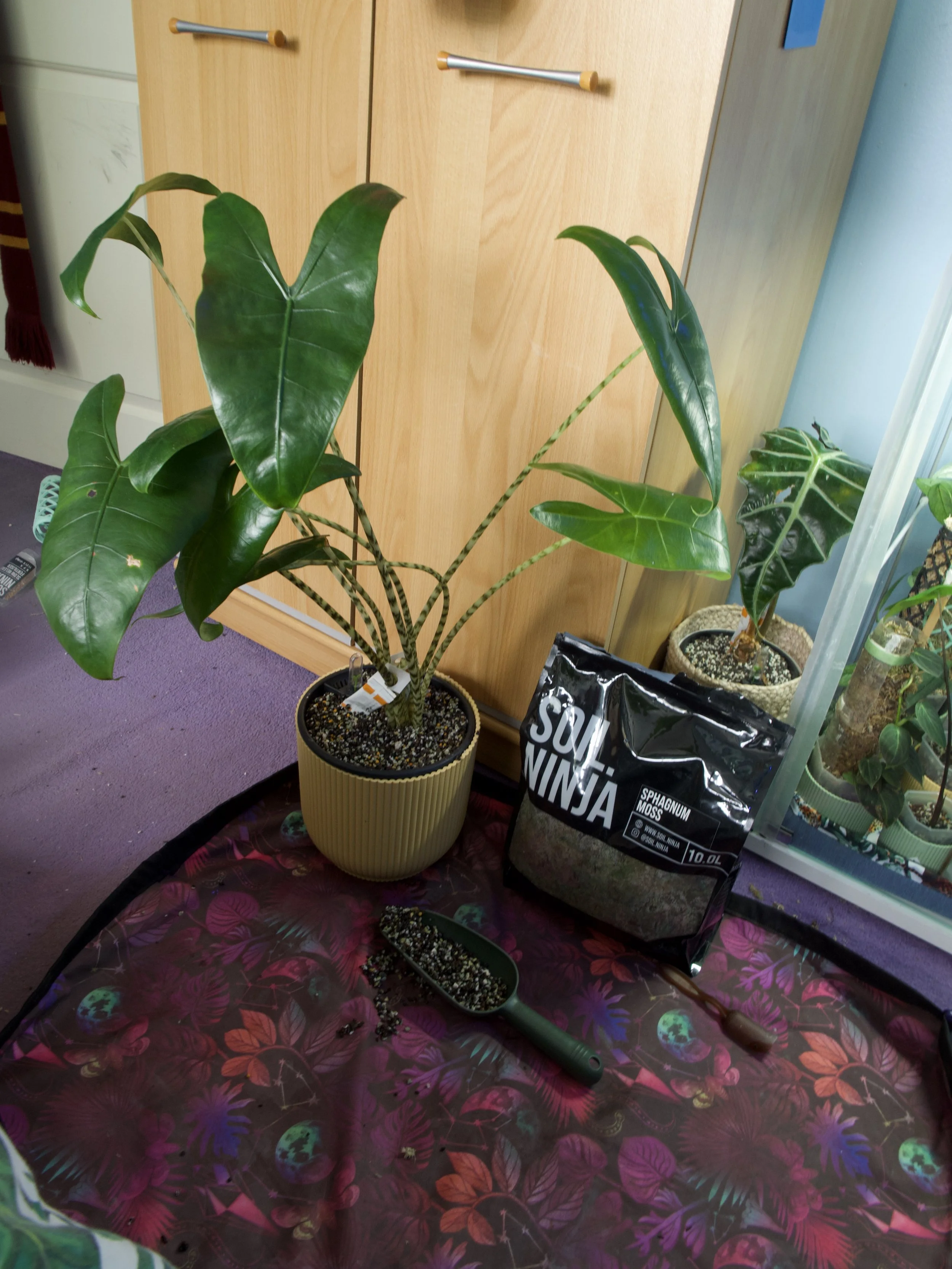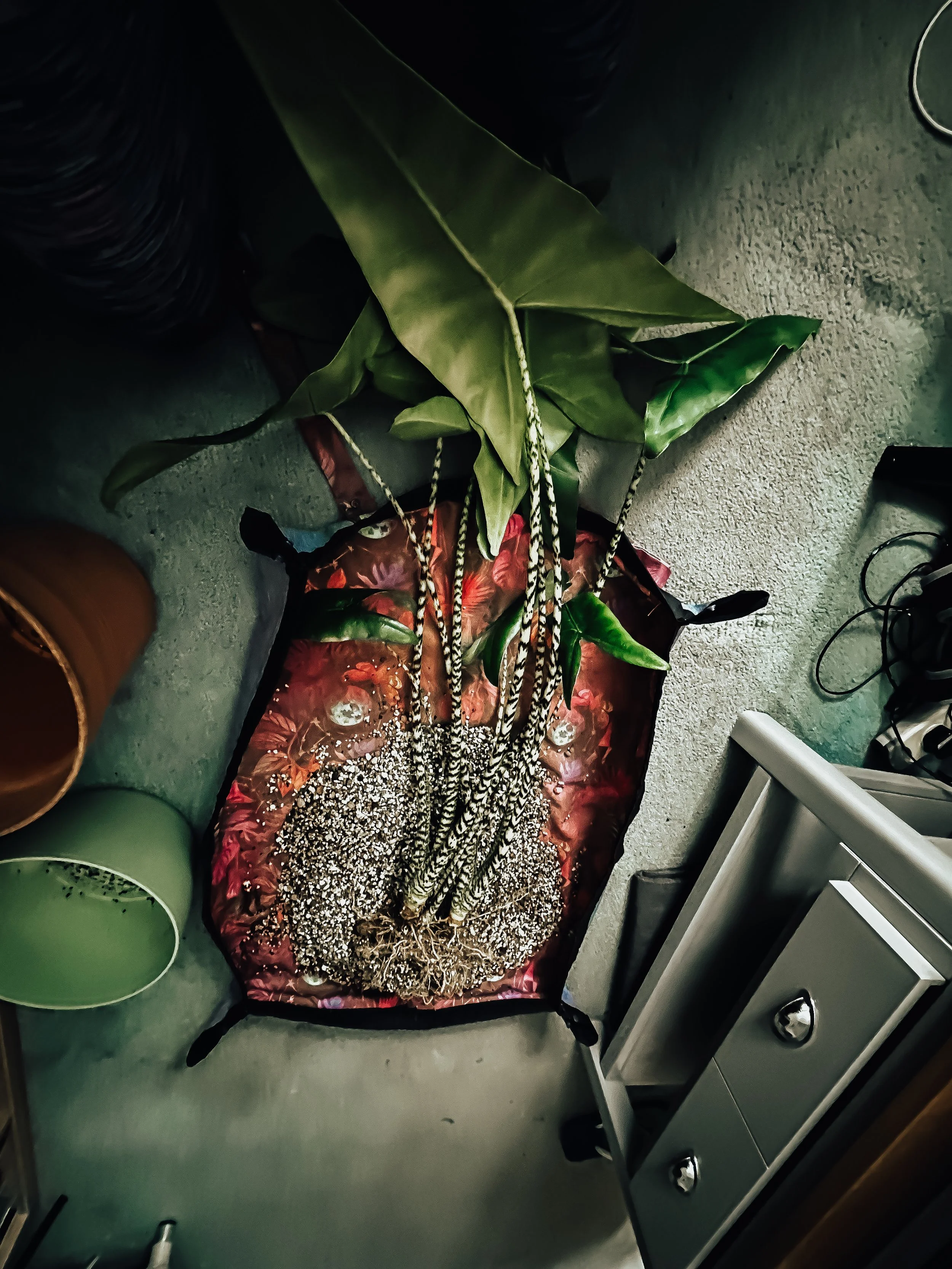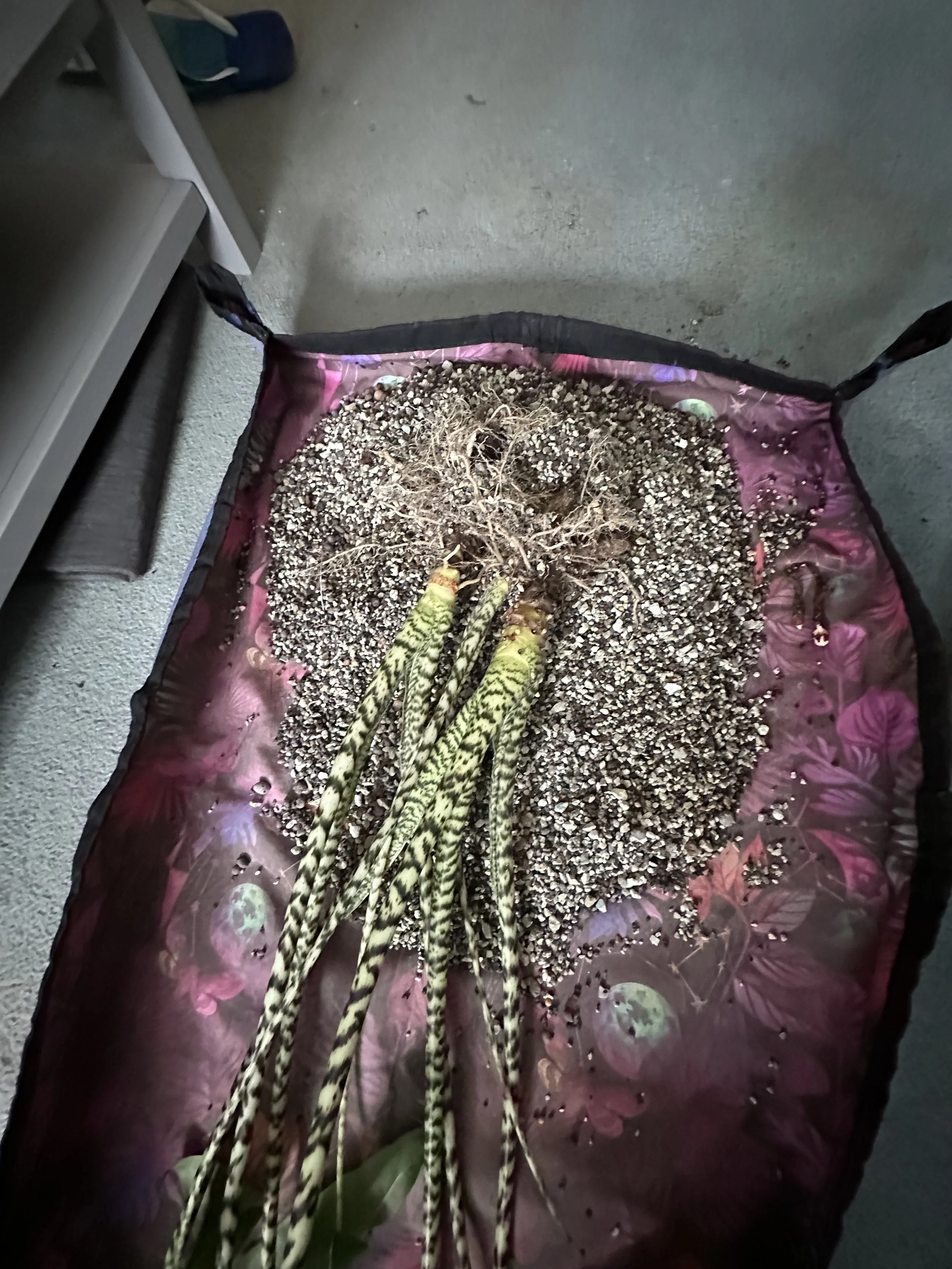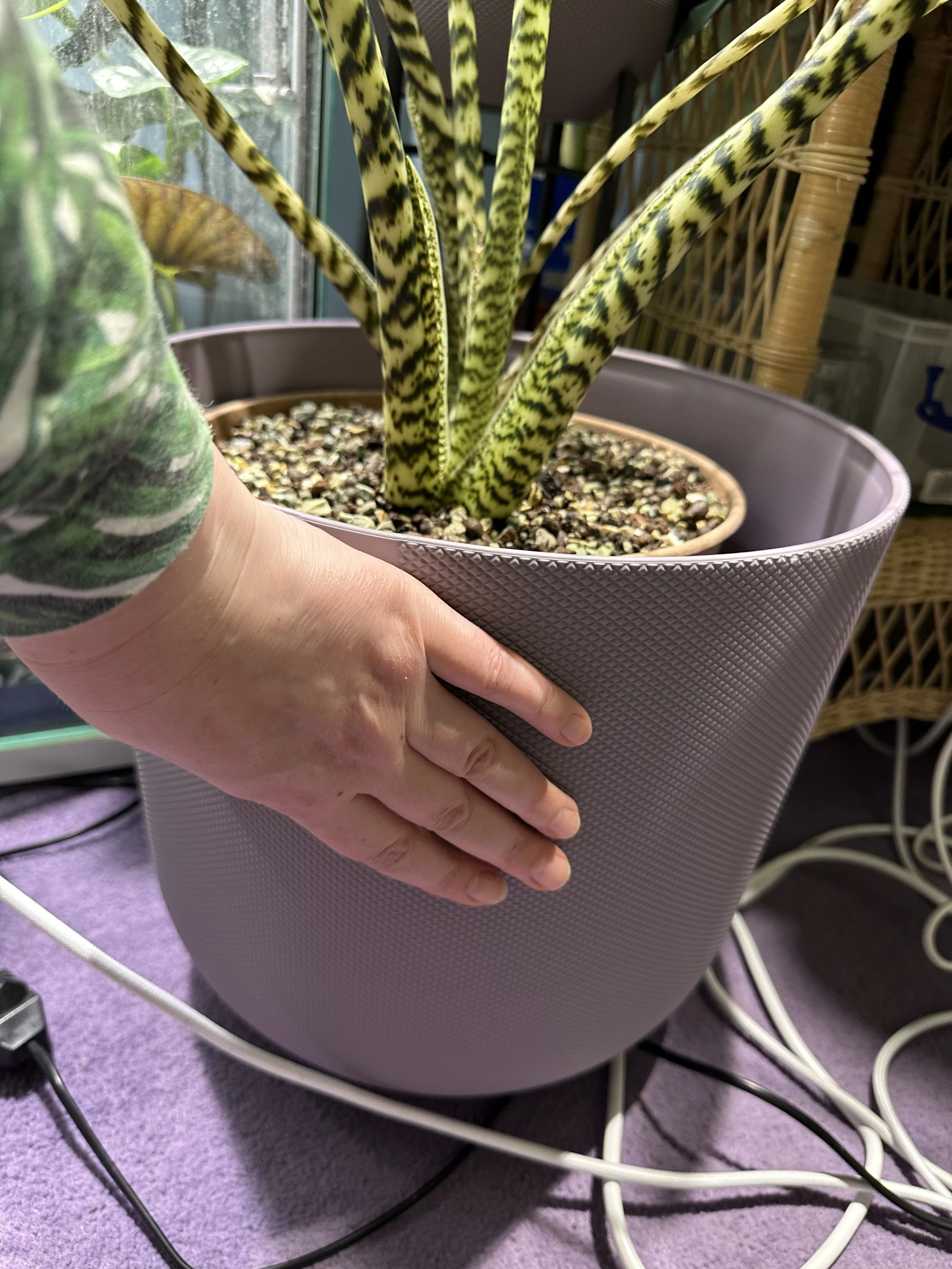Zebrina Takes the Plunge: Switching to Semi-Hydroponics
This was the Zebrina in soil ninja’s Alocasia Mix which I was happy with how it was doing however because it was a strong plant I felt it would survive the transition to Semi Hydro.
Let’s Talk About My Alocasia Zebrina’s Semi-Hydro Journey!
Join me as I take you through the journey of transferring my Alocasia Zebrina into Soil Ninja’s Semi-Hydro Fine Mix. I’ll be sharing what worked, what didn’t, and all the highs and lows along the way. I’ll also explain what semi-hydro actually is—with the help of Soil Ninja and a few other resources—so you can get your head around the method before diving into the details of my plant’s big switch.
If you’ve been following me for a while—whether on Instagram or here on the blog—you might’ve seen the video I shared at the beginning of this little adventure. But don’t worry if you missed it, because I’m starting from the top and diving into the nitty-gritty of what semi-hydro even is.
Semi-Hydro 101
So, what exactly is semi-hydro? First off, it goes by quite a few names—and it’s not just one fixed method. In simple terms, semi-hydro is a soilless growing method.
Let’s break it down. Hydro means water, and semi means “not quite”—kind of like a semi-detached house: it’s attached, but not fully joined. In plant care, this means we’re not growing in just water, but not in traditional soil either.
The “semi” part comes from the use of porous materials that allow both water and air to flow through their tiny, microscopic holes. These materials can include things like clay balls (LECA), pumice, vermiculite, unfired terracotta, biochar, perlite, timber, pulp, and sphagnum moss.
For this plant, I used Soil Ninja’s own semi-hydro blend, which they describe as:
“Our semi-hydro blend supplies porous materials & detoxifying/safeguarding amendments, all to keep your propagation & plants healthy, strong & happy.”
They actually offer two versions of this mix:
Coarse – chunkier pieces and a rougher texture
Fine – smaller particles with a finer texture
Because Alocasia roots are generally finer and more delicate than something like a Monstera or Philodendron (which tend to have chunkier roots), I went with the Fine mix—plus, they’d just released it at the time and I was excited to try it!
You can check out the video below to see exactly how I prepped my Alocasia for its semi-hydro makeover. But if you prefer a step-by-step written guide, keep scrolling! I made the switch around two years ago now, so I’ll also be sharing how it’s gone since then and how my Alocasia Zebrina is doing today.
The Switch | The Method I Used to Transition to Semi-Hydro
Strainer I use for rinsing and sterilizing semi-hydro! Got this one from Tkmax; good size, small holes, and metal.
Step One: Gather Your Tools
Here’s what I used for the switch to semi-hydro:
My plant (Alocasia Zebrina)
A potting mat
A scoop
A bag of Soil Ninja Semi-Hydro Mix
A kettle (for sterilising the mix)
A self-watering pot – I used the Elho Homes pot from Soil Ninja, but a standard aroid tower pot works too
A strainer
A bucket or tub for rinsing the mix
If you're upsizing your pot, make sure the new one isn’t too much bigger than the root ball—a jump that’s too big can lead to overwatering issues.
What I’ve learned:
I needed a strainer with smaller holes for the fine mix. I even made my own at one point, but it didn’t catch all the fine particles. Eventually, I found a great strainer at TK Maxx with tiny holes. Some grains still slipped through, but most of the semi-hydro stayed put. Keep an eye out for kitchen gadgets—they can come in really handy!
Step Two: Rinse & Sterilise Your Semi-Hydro Mix
I started by rinsing and sterilising the mix. While sterilising isn’t always essential, I like to be cautious—especially when I’m working with a new mix or repotting a sensitive plant.
To do this, I pour hot (not boiling) water over the mix in a strainer—or sometimes through a holey ice cream tub if I’m improvising!
What I’ve learned:
You don’t need to sterilise every time—especially if you’re reusing clean mix.
It depends on your supplier; some brands pre-wash and package their mix ready to use.
Rinsing removes fine dust or particles that could clog up the mix and reduce airflow.
Step Three: Rinse Until Clear
Rinse the mix until the water runs mostly clear. I usually rinse three times just to be safe, but with Soil Ninja’s mix, two rinses are often enough.
What I’ve learned:
Soil Ninja’s semi-hydro mix takes less rinsing than something like Lechuza Pon. I think it’s because they don’t include perlite, which tends to release more dust.
Step Four: Set Up Your Potting Mat
Lay out your potting mat before you start working. Trust me, it makes a big difference—especially with finer substrates that love to bounce and roll off your table.
And no, it doesn’t have to be one of my potting mats. It could be a tray, a piece of oilcloth, or even an old tea towel in a pinch. But the flat surface really helps if you’re planning to reuse the mix later, since it stops things from getting trapped in corners or folds.
What I’ve learned:
You don’t have to sterilise every time, especially if you're reusing clean mix.
It depends on the supplier—some arrive pre-washed and ready to go.
Rinsing helps remove dust or fine particles that could block the porous structure of the mix.
Step Three: Rinse Until Clear
Rinse the semi-hydro mix until the water runs nearly clear. I usually do this three times just to be thorough, though with Soil Ninja’s mix, twice is usually enough.
what I’ve learned:
Semi hydro by soil.ninja takes less rinses than lechuza pon I think this is due to them using perlite. Which Soil.Ninja’s Semi hydro doesn’t.
Step Four: Set Up Your Potting Mat
Lay out your Potting mat—it’ll catch any spills and make clean-up easier, especially with substrates like LECA or pon. A potting Mat doesn’t need to be one of my Potting mats it could be anything.
Before we dive into Step Five, I want to share something I discovered along the way: after trying a few different repotting setups, I found that using a flat potting mat worked best for me. Unlike trays or lids, the flat surface didn’t trap the semi-hydro mix, which made it easier to clean up and reuse. Transferring the mix into a smaller container was far less messy this way—especially when you're working with finer substrates that like to scatter everywhere!
Step Five: Remove Your Plant from Soil
My Alocasia Zebrina had been growing in soil for quite some time and was mature enough to handle the transition. To remove it safely, I started by soaking the root ball in water to help loosen the soil. I then used lukewarm water from the shower to gently rinse away the remaining bits.
I found that just using my hands wasn’t enough to get the roots completely clean—rinsing with water really helped. The goal here isn’t to scrub the roots perfectly clean but to remove as much soil as possible so that the remaining roots can start adjusting to their new semi-hydro life.
Step Six: Prepare Your Pot
Choose a pot that's about an inch (2.5 cm) larger than the current one—but only if your plant actually needs upsizing. If the roots aren’t overcrowded, you can absolutely stick with the same size. Reusing a pot? Give it a good clean and sterilise it before repotting. Then, fill the bottom third with your semi-hydro mix.
One trick I use is to place the current pot inside a slightly larger one to check the size difference—you’re aiming for just 1 to 1.5 inches of extra space all around. This sizing can vary depending on the plant, but for Alocasia, smaller steps up tend to work better.
Tip: When transitioning to semi-hydro, the roots your plant currently has may not survive the change. That’s okay—the plant will often shed those roots and grow new ones better suited to the new environment. So, going up a pot size isn’t always necessary during this transition stage.
This what I used previously with my semi hydro.
Step Seven: Add Fertiliser (Optional)
At this stage, I added a slow-release fertiliser to give the plant nutrients it would normally get from soil. There are lots of feeding options out there, but this method worked best for me—especially during the transition to semi-hydro.
Over time, I’ve experimented with different options—from Soil Ninja’s slow-release fertiliser to using dried seaweed. Some semi-hydro mixes already come with added nutrients, so it's worth checking the packaging before adding anything extra.
Step Eight: Fill Around the Plant
Gently place your plant into the pot and fill in the sides with more semi-hydro mix. I find that using a scoop makes it easier to distribute the substrate evenly without damaging the roots. The goal here is to stabilise the plant while giving the roots space to breathe and grow.
Step Nine: Add Water
Once the plant is upright and stable, add a small amount of filtered or rainwater into the cover pot—just enough to reach the base of the roots. This is the beauty of semi-hydro: your plant gets consistent access to moisture with a lower risk of rot.
I’ve read that watering from the top the first time can encourage the development of water roots—and I’ve found that to be true in my own setup, too.
Sometimes I don’t even use a proper drainage pot—I just pop the plant into a clear plastic cup, and it works just fine!
A Note on Shock and Root Loss
It’s totally normal for your plant to experience some shock when switching substrates. This often means some root loss. Try not to panic—this is part of the adjustment.
As long as the rhizome isn’t fully buried or sitting in water, the plant will likely bounce back. Avoid disturbing it too much while it’s adjusting. Let the new roots grow in peace!
🌱 P.S. — I’ve created a free PDF guide to help walk you through the process step-by-step. Check it out below! ⬇️
Soil Ninja’s Semi-Hydro Fine Mix gave me a great starting point for transitioning my plants. I followed their basic instructions, and my Zebrina has been thriving ever since. But I’ll be honest—it’s easy to lose hope during the early stages. Things can look rough before they get better.
That’s why I want to share how I tweaked the process and what happened to my Zebrina from day one to where she is now. Keep reading to see what I changed—and what I learned along the way.
My Semi-Hydro Experience
I got my second Alocasia Zebrina in April 2021. I’d owned one before, but sadly lost it when I moved back home. At the time, I was still learning the ropes—figuring out what Alocasias needed and what worked best for them.
I’d already tried LECA with other plants, and while it worked well for some, I didn’t have much luck using clay balls with Alocasias. So I shelved the idea for a while. Then Soil Ninja released their Semi-Hydro mix, and that changed everything.
I started using it in June 2022 with a few of my Philodendrons. Later that summer, they launched a finer version of the mix, and I thought—why not try it with my Alocasias? That decision kicked off a whole new chapter in my plant journey.
What I’ve Learned Along the Way
If you’ve read this far—thank you! I hope by sharing my experience, I can save someone a few of the headaches I had early on.
One thing I wish someone had told me when I first got into Alocasias is this: every plant—even within the same genus—can respond differently, and there’s rarely just one right way to grow them. Finding what works for your plant takes time and experimentation.
Growing my Zebrina in semi-hydro has been a long process, full of trial and error. One big lesson I learned was the difference between root types. At first, I didn’t realise that hydro roots and water roots aren’t the same:
Water roots are thinner, more fragile, and often white or even transparent. They tend to stay near the top of the pot to access oxygen from the water surface.
Soil roots, on the other hand, are thicker, darker, and have a tougher outer layer. They anchor the plant and absorb nutrients and oxygen from the soil.
Hydro roots fall somewhere in between—they’re adapted for the airier, semi-hydro environment. But when conditions change, roots often die off and regrow in a form better suited to the new setup. So if you're seeing root loss when switching to semi-hydro—don’t panic. It's normal.
Tips from My Journey
Frequent water changes helped. Especially in the early days, regularly changing the water helped keep things oxygenated and encouraged new hydro roots to grow. Yes, it’s a bit more work—but it sped up the plant’s adaptation and kept things healthy.
Don’t worry too much about some root loss. If you're losing roots after the switch, it's likely just the plant replacing them with ones better suited to the new environment.
Be mindful of how much rhizome is buried. When potting an Alocasia into semi-hydro, make sure not to fully submerge the rhizome. Keeping it partially above the substrate helps prevent rot.
Rinse your substrate! I learned this the hard way—if you don’t rinse the mix before using it, it can clump together and reduce airflow. Since air is so important to root health (especially for Alocasias), I now use a mix of Soil Ninja’s fine and coarse semi-hydro substrates—two parts fine to one part coarse—for better aeration.
Re-growing roots in water can work. If I’ve had an Alocasia suffer root loss from underwatering, I’ve had success regrowing roots in water before moving it back into semi-hydro. But I only do this if the original roots have completely dried up.
As I continued growing my Zebrina in semi-hydro, I started adding new Zebrina plants into the same pot to help fill it out. With each addition, I noticed it took less and less time for them to bounce back from the transition—they were clearly adapting well to the setup. After a couple of months of strong growth, the plant had outgrown its pot once again, and I had to move it into a slightly bigger one.
The first image above shows my Alocasia Zebrina back in March 2022, when it was still potted in soil. The next three images track its journey after I switched to semi-hydro—starting in February 2023, then again with upgrades in May and December 2023. Within that relatively short time, I had to repot several times because it was thriving so much in semi-hydro!
One thing I noticed was that the roots had been sitting in water for quite a while. About a month ago, I repotted again, but because I’d left it so long, the roots had become tangled and were more difficult to remove—unfortunately, that meant losing quite a few. I decided not to size up this time, as the new pot was already taller than the previous one.
(Side note: I really wish it were easier to find clear plastic pots larger than 21cm!)
As you can see, she’s grown a lot, and I’m now trying to grow a new plant from one of her massive corms.
In the end, this journey with Alocasia and semi-hydro has taught me a lot about patience, observation, and letting the plant take the lead. Every Alocasia seems to have its own rhythm, and sometimes the best thing we can do is give it space, trust the process, and learn as we go.
If you’ve tried semi-hydro with Alocasia (or you're thinking about it), I’d love to hear how it’s going for you! What worked? What didn’t? Let’s keep learning from each other—because plant care is so much more fun when we share the journey. 🌿💧 If you're experimenting with semi-hydro or just learning your plant's rhythm, don’t be discouraged by setbacks—they're often just part of the learning curve. With each repot and each leaf, we get a little better at understanding what our plants need. 🌱


